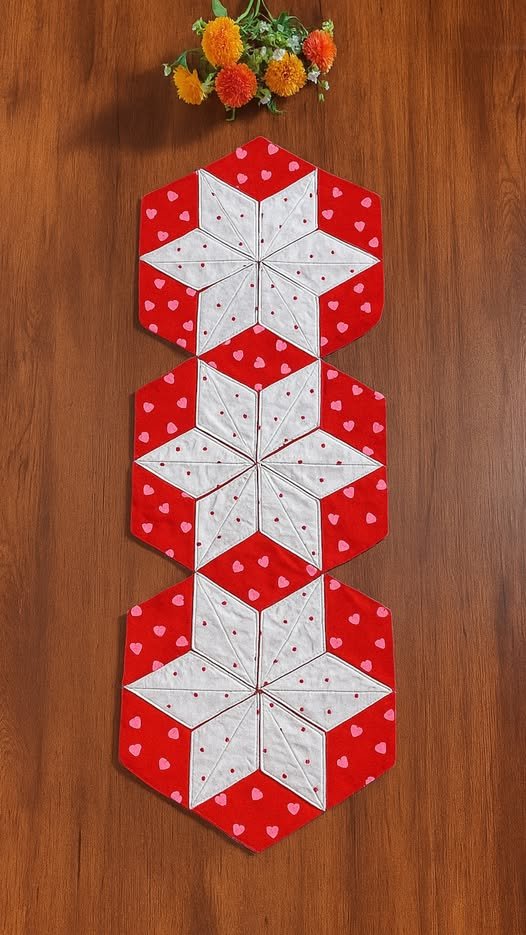Looking to add a fresh, modern twist to your dining or coffee table? This Hexagon Table Runner Tutorial – Pattern is exactly what you need. With its geometric elegance and endless fabric options, this project is the perfect way to showcase your creativity while adding functionality and charm to your home décor. Whether you’re a seasoned quilter or a sewing enthusiast trying something new, this tutorial will guide you every step of the way.
The hexagon table runner is not only visually striking but also versatile. You can choose muted tones for a minimalist look, bold prints for a statement piece, or holiday colors for seasonal charm. Its shape is naturally appealing, and the modular design makes it a fantastic stash-busting project for leftover fabrics.
Throughout this article, we’ll walk through the full Hexagon Table Runner Tutorial – Pattern from material selection to cutting, piecing, quilting, and finishing. Along the way, you’ll find helpful tips, creative ideas, and answers to common questions so you can feel confident and inspired as you sew.

1. Choosing Materials and Preparing Your Hexagons
Every successful Hexagon Table Runner Tutorial – Pattern starts with thoughtful material selection. Because the hexagon shape is central to the project, choosing fabrics that complement one another while showcasing the geometric design is key.
Start by selecting your fabric palette. You’ll need a combination of main fabrics for the hexagons and a backing fabric. This project is a great way to use fabric scraps, jelly rolls, or charm squares. Choose fabrics in coordinating colors, or mix and match for a fun, scrappy look.
100% quilting cotton is ideal for this project. It’s easy to cut, holds its shape well, and presses cleanly. If you plan to use your table runner frequently, consider pre-washing your fabrics to prevent shrinkage after your project is complete.
Next, you’ll need to prepare your hexagon templates. These can be cut from plastic, cardstock, or purchased as acrylic quilting templates. A common size is 4″ across from flat side to flat side, but you can adjust depending on your desired runner size.
For accurate piecing, cutting your hexagons carefully is crucial. Use a rotary cutter, quilting ruler, and cutting mat. You can trace your template onto fabric and cut with scissors or use the template as a guide for rotary cutting directly.
You’ll also need a lightweight batting, thread to match or contrast with your fabric, and basic sewing tools. Optional but helpful: pins or fabric clips, a walking foot for quilting, and a hot iron for pressing seams.
Finally, consider your layout. Will your runner be a single row of hexagons? Will they be staggered or connected edge-to-edge? Planning your layout ahead helps determine how many hexagons to cut and how long the finished runner will be.
2. Sewing Techniques and Piecing Your Hexagons
Once your materials are ready, the next step in this Hexagon Table Runner Tutorial – Pattern is assembling your pieces with precision. Hexagons can seem intimidating at first, but with the right technique, they come together beautifully.
There are two primary methods for assembling hexagons: hand sewing with English Paper Piecing (EPP) or machine piecing. For a quicker project, most choose machine piecing, but EPP can offer more control for beginners.
Begin by sewing hexagons into rows. To do this by machine, place two hexagons right sides together and sew from point to point using a ¼-inch seam allowance, stopping at the seam intersections to allow for flexibility when attaching other hexagons.
Press your seams as you go, either open or to one side. Open seams reduce bulk, especially where multiple points meet. Be patient—hexagon points require careful alignment to maintain symmetry.
As you continue building your rows, remember that staggered rows (also called offset rows) create a more dynamic, flowing effect. You may need to trim the edges or add half-hexagons to straighten the sides for a clean edge.
Once your rows are complete, join the rows together using the same careful stitching and pressing technique. It’s helpful to pin at each intersection to maintain alignment and avoid shifting during sewing.
At this stage, you should have a full quilt top in the desired size. Lay it out flat and check for any puckering or misalignment. Making small adjustments now ensures a cleaner finished product when you begin quilting.
3. Quilting and Finishing the Table Runner
After completing the piecing phase of the Hexagon Table Runner Tutorial – Pattern, it’s time to quilt and finish your project. This is where your runner truly comes to life with texture, dimension, and personality.
Start by creating your quilt sandwich: lay the backing fabric (right side down), place the batting on top, then add your pieced hexagon top (right side up). Smooth out each layer to avoid wrinkles and baste using pins or basting spray.
You can now choose your quilting method. For beginners, straight-line quilting following the seams works wonderfully. Use a walking foot for even stitching and quilt along each edge of the hexagons or diagonally across the rows.
More advanced quilters might opt for free-motion quilting, adding swirls, flowers, or echo lines that complement the floral or geometric design of the runner. Always test your stitches on a scrap quilt sandwich before beginning on your main project.
When quilting is complete, trim the edges. If your hexagons extend to the outer edges in a staggered shape, you can bind around the curves or trim them into a straight edge, depending on your preference and comfort level with binding angles.
Finish by adding binding around the edge. You can use straight-grain binding for straight edges or bias binding for curved or angled edges. Choose a coordinating or contrasting fabric to frame your work beautifully.
Give your finished table runner a final press with a hot iron, and it’s ready to display! Whether used on a dining table, console, or coffee table, your handcrafted runner adds a touch of warmth and artistry to any space.
4. Customization Ideas and Seasonal Variations
One of the best things about this Hexagon Table Runner Tutorial – Pattern is how easily it can be customized. From fabrics to finishes, there’s no limit to how creative you can be with this project.
For a modern farmhouse look, choose neutral tones like beige, gray, and white. Add a touch of black for contrast, and use minimal quilting lines for a clean, contemporary feel.
To make a holiday-themed runner, pick colors and prints that reflect the season. Reds and greens for Christmas, pastels for Easter, oranges and browns for fall, or patriotic colors for the Fourth of July.
Create a scrappy version by using leftover fabric from other projects. This sustainable approach results in a colorful, one-of-a-kind piece that tells a story with every hexagon.
You can also experiment with size and shape. Instead of a long narrow runner, make a hexagon-shaped placemat or square centerpiece using the same principles. Adjust your template size for different effects.
Personalize your runner with embroidery, monograms, or appliqué. Add a family name, seasonal motif, or small details like hearts or stars to make the piece truly yours.
Finally, consider gifting your hexagon table runner. Handmade gifts like this are cherished by friends and family, especially when tailored to their style or home décor. Wrap it with ribbon and a handmade tag for a thoughtful presentation.
FAQ – Hexagon Table Runner Tutorial – Pattern
Q1: Is this project suitable for beginners?
Yes! The Hexagon Table Runner Tutorial – Pattern is beginner-friendly, especially when using machine piecing. English Paper Piecing is also a great slow-paced method for learning.
Q2: What size should my hexagons be?
A common size is 4″ flat side to flat side, but you can adjust depending on the desired length and width of your runner. Larger hexagons = faster project.
Q3: Do I need a special template?
Not necessarily. You can print hexagon templates online or use a quilting ruler with a 60-degree angle. Acrylic templates offer accuracy and ease.
Q4: What fabrics are best for this pattern?
100% cotton quilting fabric is ideal. It’s easy to sew, holds its shape, and is widely available in beautiful prints and solids.
Q5: Can I quilt this by hand?
Absolutely! Hand quilting is a beautiful way to finish this project, though it takes more time. Choose a simple stitch and use a quilting hoop for control.
Q6: How do I prevent stretching when sewing hexagons?
Starch your fabric before cutting and handle pieces gently. Using pins or clips at seam intersections helps maintain shape during piecing.
Conclusion
Creating a Hexagon Table Runner is more than just a fun sewing project—it’s an opportunity to express your creativity, learn new skills, and produce something beautiful and functional. With this Hexagon Table Runner Tutorial – Pattern, you now have all the tools, techniques, and inspiration to start your own.
From choosing fabrics and cutting templates to sewing, quilting
, and customization, we’ve covered every step to help you succeed. Whether you’re making it for yourself, a loved one, or your craft booth, this project offers endless possibilities.
Have you made your own hexagon runner using this tutorial? We’d love to hear from you! Share your thoughts, tips, or finished photos in the comments. Your feedback helps others learn and keeps the handmade community thriving.
Happy sewing! 🧵💛

